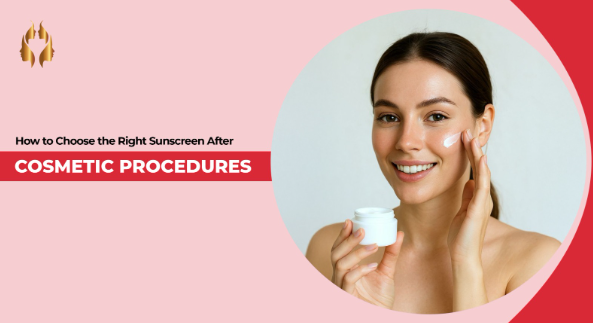Blog Details
Home > Blog> Blog Details

Successful Surgeries
Doctors
Happy Patients
If you got any questions, please do not hesitate to send us a message. We reply within 24 hours.
How to Choose the Right Sunscreen After Cosmetic Procedures
The skin is usually susceptible to a chemical peel, laser session or injectables. Procedures cause momentary thinning of the protective stratum corneum causing it to be vulnerable to ultraviolet damage and inflammation. In the absence of sun protection, you are likely to develop hyper-pigmentation, delayed healing or early ageing. The most crucial thing in your aftercare is the use of a broad spectrum SPF.
Locate general-purpose, High-SPF Formulas
In broad-spectrum coverage: It is advised that individuals apply sunscreens with broad-spectrum coverage, i.e. covers both UVA and UVB spectrum. UVA rays accelerate the aging and pigmentation process but UVB rays cause sunburn. They both have a wide-spectrum formulation.
SPF 30 and over: Microneedling or laser resurfacing subjects the skin to delicate circumstances; the application of no less than SPF 30 will assist in safeguarding the skin. Higher SPFs would be meaningless to some extent, but it is essential that a reapplication is made. Greater SPFs can be of slight use, but a reapplication is important.
Waterproof: Treatments can activate sweating, or can require a lot of washing. A moisture-resistant sunscreen will take 4080-minutes even when used in a wet environment.
Select Physical (Mineral) Filters with Sensitive Skin
Titanium dioxide or zinc oxide are used as physical sunscreens that are applied to the skin and reflect UV rays. According to Aethos NYC, they are suitable to use after the surgery as they have a broad-spectrum protection, and they are less irritating. Use no chemical filters containing fragrances or alcohol which may sting the damaged skin. There is a hypoallergenic fragrance-free formula, which minimizes the chances of inflammation.
Redo and Enhance with other Protective Habits
Sunscreen application is a must after a cosmetic treatment. According to Aethos, application should be done twice a day after a two-hour interval and after exercise or swimming. Another useful thing could be a travel size mineral powder/spray because then you can fix them up whenever you want. Spending time in the shade, putting wide-brimmed hats and protective clothes on and spending at least a week avoiding sun exposure in the daytime after surgery is not enough.
Make Your Sunscreen Procedure-Specific
Peels and microdermabrasion: Select a relaxing formula with added antioxidants or niacinamide to cool the redness. The skin can become flake/peel, therefore use heavy creams sparingly which cover the pores.
Laser resurface: Sunscreens with high SPF and water resistance offer sufficient protection to the new exposed fragile skin. Mineral sticks are convenient to use in the spot-application of treated areas.
Injectables (Botox, fillers): regular broad-spectrum sunscreens are sufficient, although it is stressed in the Aethos article not to expose treated areas to direct sunlight and not use tanning beds.
Final Thoughts
The best sunscreen is that which you are going to use regularly. Apply a very broad spectrum, SPF 30 or higher mineral formula, reapply it often and use it with sun-avoidance protection. The time spent on your cosmetics in proper care will make your investment work well, and you will get long-term outcomes.
Copyright reserved @ 2023 Raj Cosmetic & Plastic Surgery Centre